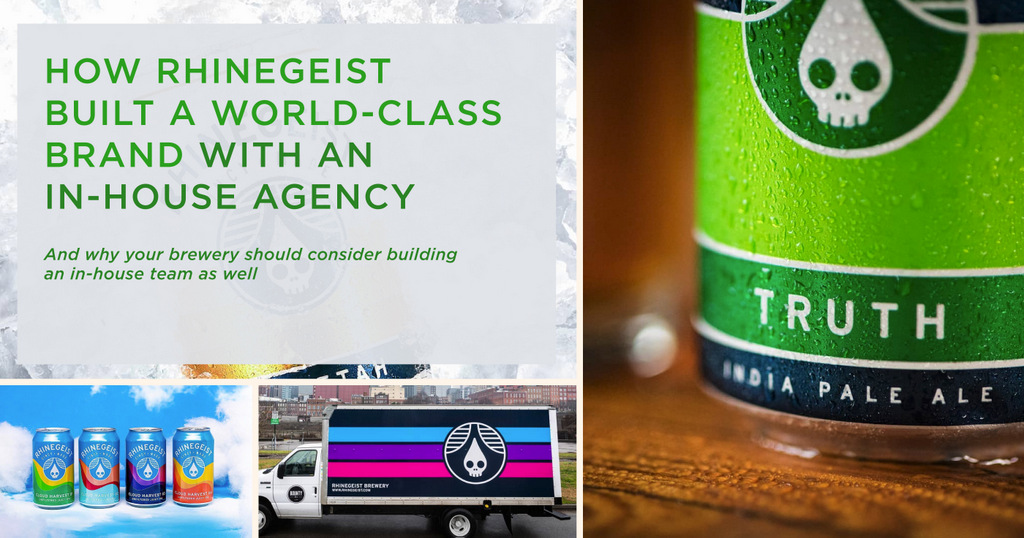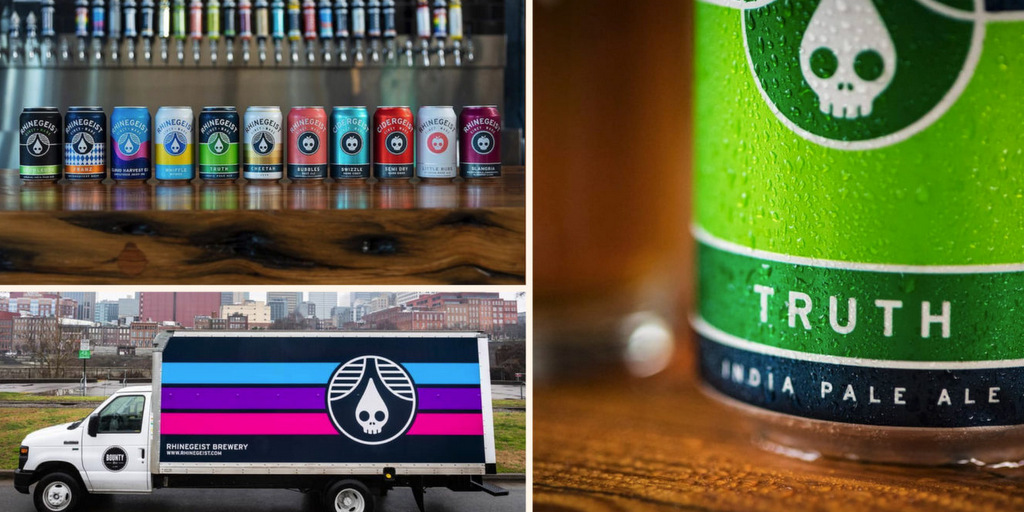Join 5,000+ other brewing industry folks on CODO Design’s Beer Branding Trends newsletter to receive monthly field notes covering trends, currents and actionable advice from the front lines of beer branding.

Rhinegeist Brewery opened its doors in 2013 and has grown to become the 26th largest brewery in the United States. With 8,300+ breweries now open across the United States, it’s doubtful that we’ll ever see a brewery open and grow to this scale again (though I’d love to be proven wrong).
To reach this rarefied air, a brewery has to get everything right. The beer has to be phenomenal, the marketing and sales need to work in lockstep and the behind-the-scenes financials and business itself needs to be perfectly run. And perhaps most importantly, this would never happen without world-class branding.
It may seem counterintuitive for a branding firm to tell you that your brewery should consider building an in-house design and marketing team, but CODO has made this very suggestion to dozens of growing breweries.
If you’re investing heavily in a rebrand, for instance, an in-house team is a great way to protect this investment. A well run, internal team keeps your messaging timely and consistent and can shape the overall brand and customer experience on an ongoing basis.
Your next read? Maybe our Sober Up series of investigative reports. Check this out. “Sober Up: The nascent Michigan hop industry won’t survive without your help.”
I’m excited to talk with Greg Althoff, Creative Director of Rhinegeist Brewery about this very topic. Greg oversees a small team at Rhinegeist.
We discuss his role as Creative Director, how to set goals as an in-house team, how his team collaborates with the other groups within Rhinegeist as well as one of my favorite topics — how can a brewery stay relevant and exciting while it continues to scale.
Isaac (CODO): Hey Greg. Please introduce yourself and tell everyone what you do at Rhinegeist Brewery.
Greg: I’m the Creative Director at Rhinegeist Brewery, and primarily, I lead design for a variety of projects from concept through production. I collaborate with the founders and senior leadership on planning and strategy for our business, identifying creative opportunities that push our brand forward.
CODO: Can you give us a run down on Rhinegeist — how old is the brewery, when was it founded, what kind of beers do you brew, annual bbl production and distribution footprint?
Greg: Rhinegeist is coming up on eight years old, founded in 2013.
I think we’re really good at brewing great beer across a wide spectrum — everything from our sours and barrel-aged programs to our flagship IPA, Truth, to something like Bubbles which more or less launched the Rosé trend. Our brewers want to be good at everything.
We get about 100k bbls out of a pretty small footprint — Ohio, Kentucky, Indiana and parts of Pennsylvania, Tennessee and Wisconsin. Even though we grew pretty quickly, I think we have a fairly sustainable, long-term view of our growth as a company.
As proof, the owners are going to begin the process of selling the company back to the employees next year. We’re trying to build a great company that people can be proud of which will be around for the long-haul.
CODO: Give us a rundown of your creative department. How many designers, social media folks, etc. round out your team?
Greg: Well, we have myself and the Marketing Director, three designers, two social media folks and two project managers. It’s probably a big team in context of the rest of the craft beer industry, but if you see brand as one of your most valuable assets as a business, it isn’t very large.

CODO: What challenges do you face as creative director for one of the largest craft breweries in the country?
Greg: As recently as three years ago, the role of marketing at a brewery like Rhinegeist was to make really cool label art, merch and parties and share it on social media. The consumers would then follow.
I think the biggest challenge is how we can shift from an era of easy, organic category growth into an era where demand is something that marketing is responsible for creating for our products.
The category is starting to evolve into a more traditional CPG category. Well, there are reasons why big CPG brands invest in things like advertising and sponsorships and things of that nature, because they create demand for their products. How do you evolve in that direction without losing your soul?
CODO: Historically, marketing has been viewed as a thing you bring in at the end to move a product — something you need to begrudgingly spend money on. Tell me why that’s wrong and how you view marketing’s role in running a successful brewery.
Greg: It’s really easy to draw a line between sales and production and profit. A new fermenter will cost $X and deliver $10X in revenue. A new salesperson will deliver $3X of their salary. So on and so forth.
If you embrace the Coke example above (and I think the smart breweries will), that there is this thing called Brand (your reputational value). That Brand is one of the most valuable assets for your company and that you can make it more valuable, then investing in marketing isn’t such a crazy thing after all.
Just because it’s an intangible thing doesn’t mean it isn’t real. You get a Brand whether you like it or not. Whether you choose to influence it or not is the choice you make. Plain and simple, the category is shifting from easy, organic growth to one where demand is created for its products and the way you do that is with marketing. The free ride is over.
Read the rest of this post over on CODO’s site: https://cododesign.com/in-house-with-rhinegeist-brewery/
This piece was provided by CODO Design, a food and beverage branding firm, and authors of Craft Beer, Rebranded. This book (and companion workbook) is a step-by-step guide to help you map out a successful strategy for rebranding your brewery.






Leave a Reply
You must be logged in to post a comment.